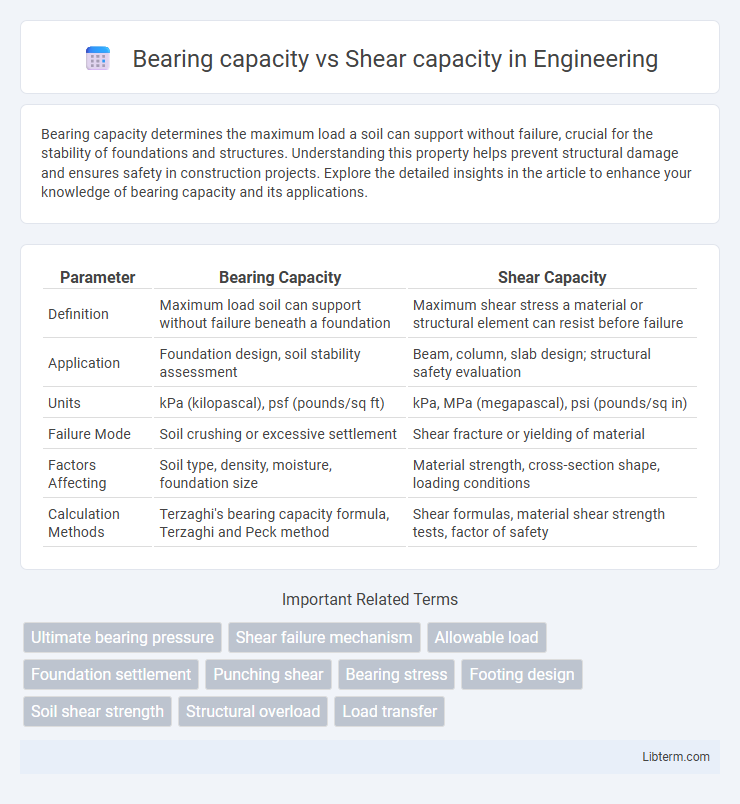Bearing capacity determines the maximum load a soil can support without failure, crucial for the stability of foundations and structures. Understanding this property helps prevent structural damage and ensures safety in construction projects. Explore the detailed insights in the article to enhance your knowledge of bearing capacity and its applications.
Table of Comparison
| Parameter | Bearing Capacity | Shear Capacity |
|---|---|---|
| Definition | Maximum load soil can support without failure beneath a foundation | Maximum shear stress a material or structural element can resist before failure |
| Application | Foundation design, soil stability assessment | Beam, column, slab design; structural safety evaluation |
| Units | kPa (kilopascal), psf (pounds/sq ft) | kPa, MPa (megapascal), psi (pounds/sq in) |
| Failure Mode | Soil crushing or excessive settlement | Shear fracture or yielding of material |
| Factors Affecting | Soil type, density, moisture, foundation size | Material strength, cross-section shape, loading conditions |
| Calculation Methods | Terzaghi's bearing capacity formula, Terzaghi and Peck method | Shear formulas, material shear strength tests, factor of safety |
Introduction to Bearing Capacity and Shear Capacity
Bearing capacity refers to the ability of soil or a foundation material to support the loads applied from a structure without experiencing shear failure or excessive settlement. Shear capacity is the maximum shear stress that a material, such as soil or concrete, can withstand before failure occurs, crucial in assessing slope stability and structural integrity. Understanding the distinction between bearing capacity and shear capacity is vital for designing safe foundations and ensuring the stability of soil-structure systems under various loading conditions.
Defining Bearing Capacity
Bearing capacity refers to the maximum load per unit area that soil can support without undergoing shear failure or excessive settlement, crucial in foundation design. It ensures structures do not sink or tilt by resisting loads applied by footings, piles, or other supports. Shear capacity, by contrast, measures the soil's ability to resist deformation due to shear stress, highlighting the difference between vertical load bearing and lateral soil stability.
Understanding Shear Capacity
Shear capacity refers to the maximum shear force a structural element can withstand before failure occurs, which is critical for ensuring stability in beams, columns, and foundations. Unlike bearing capacity, which deals with the ability of soil or a support to resist compression loads, shear capacity focuses on resisting forces that cause sliding or diagonal cracking within materials. Accurate assessment of shear capacity requires analyzing factors such as material strength, cross-sectional geometry, and loading conditions to prevent sudden structural failures.
Key Differences Between Bearing and Shear Capacity
Bearing capacity refers to the maximum load a soil or foundation can support without experiencing failure or excessive settlement, while shear capacity relates to the maximum shear stress a material or structure can withstand before shear failure occurs. Bearing capacity is crucial for foundation design, ensuring stability under vertical loads, whereas shear capacity is essential for assessing resistance to sliding or shear-induced deformation in structural elements. Understanding these distinctions allows engineers to design safe foundations and structural components that appropriately manage vertical loads and shear forces.
Factors Affecting Bearing Capacity
Bearing capacity depends heavily on soil type, density, moisture content, and foundation depth, influencing the soil's ability to support loads without failure. Shear capacity is affected by soil cohesion, internal friction angle, and pore water pressure, determining the soil's resistance to shear stress. Variations in grain size distribution and consolidation state also critically impact bearing capacity, affecting overall foundation stability and design considerations.
Factors Influencing Shear Capacity
Shear capacity is primarily influenced by factors such as the material properties of concrete and reinforcement, the presence of shear reinforcement, concrete compressive strength, aggregate interlock, and the size and shape of the member. Bearing capacity depends on soil strength, footing size, and the stress distribution beneath the foundation, which differ fundamentally from factors affecting shear capacity in structural elements. Effective shear capacity design must consider crack width control, concrete tensile strength, and the orientation and spacing of stirrups to ensure structural stability.
Methods for Determining Bearing Capacity
Methods for determining bearing capacity include Terzaghi's bearing capacity theory, Meyerhof's method, and the Hansen approach, each incorporating soil parameters like cohesion, angle of internal friction, and effective stress. Plate load tests and standard penetration tests (SPT) provide empirical data to validate theoretical calculations, enhancing accuracy in predicting soil bearing capacity under various loading conditions. Finite element analysis (FEA) is increasingly used to simulate complex soil-structure interactions, offering detailed insights into bearing capacity and potential failure mechanisms.
Techniques for Assessing Shear Capacity
Shear capacity evaluation techniques include direct shear tests, torsional tests, and finite element analysis to determine a material's resistance against shear forces. Empirical formulas, such as those based on the Mohr-Coulomb criterion, offer parametric insights by relating shear strength to cohesion and internal friction angles. Advanced methods like digital image correlation and acoustic emission monitoring enhance accuracy by detecting micro-crack propagation and failure points under shear stress.
Practical Applications: Bearing vs. Shear Capacity
Bearing capacity determines the maximum load a foundation soil can support without failure, critical for designing stable foundations in construction projects. Shear capacity is essential for assessing the ability of soil or structural elements to resist shear stress, preventing sliding or structural collapse. Practical applications prioritize bearing capacity for foundation sizing and shear capacity for evaluating slope stability, retaining walls, and structural connections.
Design Considerations and Safety Implications
Bearing capacity refers to the maximum load a soil or foundation can support without failure, while shear capacity relates to the material's resistance to shear stress before rupture. In design considerations, engineers must evaluate both capacities to ensure structural stability, accounting for factors such as soil type, load characteristics, and safety factors specified in relevant codes like ACI or Eurocode. Safety implications include preventing foundation settlement from inadequate bearing capacity and avoiding structural failure due to shear, thus maintaining overall integrity and durability under service conditions.
Bearing capacity Infographic

 libterm.com
libterm.com